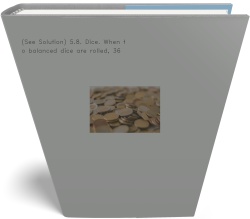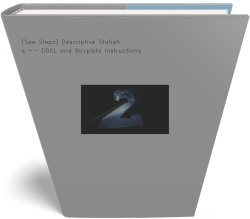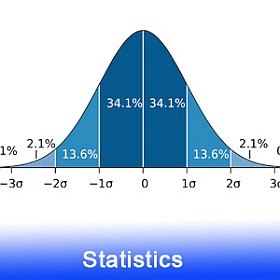4.10. Murder Victims. As reported by the Federal Bureau of Investigation in Crime in the United States,
4.10. Murder Victims. As reported by the Federal Bureau of Investigation in Crime in the United States, the age distribution of murder victims between 20 and 59 years old is as shown in the following table.
A murder case in which the person murdered was between 20 and 59 years old is selected at random. Find the probability that the murder victim was
- between 40 and 44 years old, inclusive.
- at least 25 years old, that is, 25 years old or older.
- between 45 and 59 years old, inclusive.
- under 30 or over 54 .
4.14. Coin Tossing. A balanced dime is tossed three times. The possible outcomes can be represented as follows.
Here, for example, HHT means that the first two tosses come up heads and the third tails. Find the probability that
- exactly two of the three tosses come up heads.
- the last two tosses come up tails.
- all three tosses come up the same.
- the second toss comes up heads.
4.22. Construct a Venn diagram representing each event.
- (not E)
- A or B)
- A & B
- A & B & C
- A or B or C
- (not A) & B
4.30. Protecting the Environment. A survey was conducted in Canada to ascertain public opinion about a major national park region in the Banff-Bow Valley. One question asked the amount that respondents would be willing to contribute per year to protect the environment in the Banff-Bow Valley region. The following frequency distribution was found in an article by J. Ritchie, S. Hudson, and S. Timur, titled "Public Reactions to Policy Recommendations from the Banff-Bow Valley Study"
For a respondent selected at random, let
For a respondent selected at random, let
A = event that the respondent would be willing to contribute at least $101,
B = event that the respondent would not be willing to contribute more than $50,
C = event that the respondent would be willing to contribute between $1 and $200, and
D =event that the respondent would be willing to contribute at least $1.
Describe the following events in words and determine the number of outcomes (respondents) that make up each event.
- not D
- A & B
- C or A
- B & D
4.40. Home Internet Access. The online publication CyberStats, by Mediamark Research, Inc., reports Internet access and usage. The following is a percentage distribution of household income for households with home Internet access only.
Suppose that a household with home Internet access only is selected at random. Let A denote the event the household has an income under $ 50,000, B denote the event the household has an income between $ 50,000 and $75,000, and so on (see the third column of the table). Apply the special addition rule to find the probability that the household obtained has an income
- under $75,000.
- $50,000 or above.
- between $50,000 and $150,000.
- Interpret each of your answers in parts (a)-(c) in terms of percentages.
4.44. Home Internet Access. Solve part (b) of Exercise 4.40 by using the complementation rule. Compare your work here to that in Exercise 4.4 b) where you used the special addition rule.
4.56. Motor Vehicle Use. The U.S. Federal Highway Administration compiles information on motor vehicle use Statistics. Following is a contingency table for the highway of motor vehicles in use in North American countries by country and type of vehicle. Frequencies are in thousands.
- How many cells are in this contingency table?
- How many vehicles are Canadian?
- How many vehicles are motorcycles?
- How many vehicles are Canadian motorcycles?
- How many vehicles are either Canadian or motorcycles?
- How many automobiles are Mexican?
- How many vehicles are not automobiles?
4.60. Motor Vehicle Use. Refer to Exercise 4.56.
For a randomly selected vehicle, describe the events C1, V3, and C1 & V3 in words.
b. Compute the probability of each event in part (a).
c. Compute P(C1 or V3), using the contingency table and the f / N rule.
d. Compute P (C1 or V3), using the general addition rule and your answers from part (b).
e. Construct a joint probability distribution.
4.66. Housing Units. The U.S. Bureau of the Census publishes data on housing units in American Housing Survey in the United States. The following table provides a frequency The frequencies are
Compute the following conditional probabilities directly; that is, do not use the conditional probability rule. For a U.S. housing unit selected at random, determine
- the probability that the unit has exactly four rooms.
- the conditional probability that the unit has exactly four rooms, given that it has at least two rooms.
- the conditional probability that the unit has at most four rooms, given that it has at least two rooms.
- Interpret your answers in parts (a)-(c) in terms of percentages.
4.68 Shark Attacks. The International Shark Attack File, maintained by the American Elasmobranch Society and the Florida Museum of Natural History, is a compilation of all known shark attacks around the globe from the mid-1500s to the present. Following is a contingency table providing a cross-classification of worldwide reported shark attacks during the 1990’s, by country and lethality of attack.
- \(\Pr ({{C}_{2}})\)
- \(\Pr ({{C}_{2}}\cap {{L}_{1}})\)
- \(\Pr ({{L}_{1}}|{{C}_{2}})\)
- \(\Pr ({{L}_{1}}|{{C}_{2}})\)
4.78. Injured Americans. The U.S. National Center for Health Statistics compiles data on injuries and publishes the information in Vital and Health Statistics. A contingency table for injuries in the United States, by circumstance and gender, is as follows. Frequencies are in millions.
- Find \(\Pr \left( {{C}_{1}} \right)\).
- Find \(\Pr ({{C}_{1}}|{{S}_{2}})\)
- Are events \({{C}_{1}}\) and \({{S}_{2}}\) independent? Explain your answer.
- Is the event that an injured person is male independent of the event that an injured person was hurt at home? Explain your answer.
4.112. Poker. A poker hand consists of 5 cards dealt from a1 ordinary deck of 52 playing cards.
- How many poker hands are possible?
- How many different hands consisting of three kings and two queens are possible?
- The hand in part (b) is an example of a full house: 3 cards of one denomination and 2 of another. How many different full houses are possible?
- Calculate the probability of being dealt a full house.
Deliverable: Word Document



![[Solution] The Pepsi/Coke Challenge Student Online Guide Supplies [Solution] The Pepsi/Coke Challenge Student Online Guide](/images/solutions/MC-solution-library-80466.jpg)
![[Solution Library] Part 1: Subjective Probabilities with Pennies [Solution Library] Part 1: Subjective Probabilities with](/images/solutions/MC-solution-library-80467.jpg)
![[See Solution] Gather data: Gather a list of the names of all [See Solution] Gather data: Gather a list](/images/solutions/MC-solution-library-80468.jpg)

